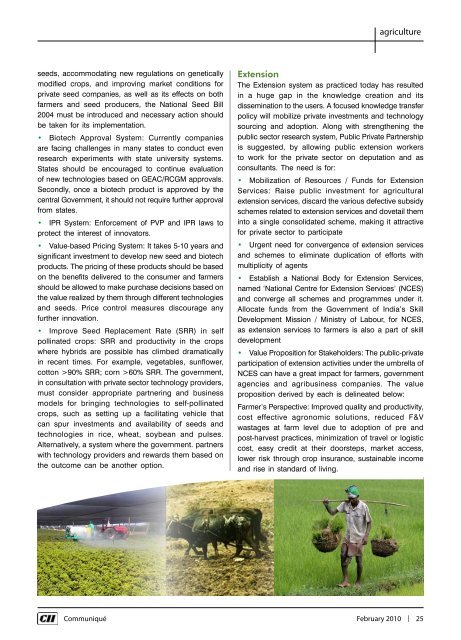CII Communique - February, 2010
CII Communique - February, 2010
CII Communique - February, 2010
You also want an ePaper? Increase the reach of your titles
YUMPU automatically turns print PDFs into web optimized ePapers that Google loves.
agriculture<br />
seeds, accommodating new regulations on genetically<br />
modified crops, and improving market conditions for<br />
private seed companies, as well as its effects on both<br />
farmers and seed producers, the National Seed Bill<br />
2004 must be introduced and necessary action should<br />
be taken for its implementation.<br />
• Biotech Approval System: Currently companies<br />
are facing challenges in many states to conduct even<br />
research experiments with state university systems.<br />
States should be encouraged to continue evaluation<br />
of new technologies based on GEAC/RCGM approvals.<br />
Secondly, once a biotech product is approved by the<br />
central Government, it should not require further approval<br />
from states.<br />
• IPR System: Enforcement of PVP and IPR laws to<br />
protect the interest of innovators.<br />
• Value-based Pricing System: It takes 5-10 years and<br />
significant investment to develop new seed and biotech<br />
products. The pricing of these products should be based<br />
on the benefits delivered to the consumer and farmers<br />
should be allowed to make purchase decisions based on<br />
the value realized by them through different technologies<br />
and seeds. Price control measures discourage any<br />
further innovation.<br />
• Improve Seed Replacement Rate (SRR) in self<br />
pollinated crops: SRR and productivity in the crops<br />
where hybrids are possible has climbed dramatically<br />
in recent times. For example, vegetables, sunflower,<br />
cotton >90% SRR; corn >60% SRR. The government,<br />
in consultation with private sector technology providers,<br />
must consider appropriate partnering and business<br />
models for bringing technologies to self-pollinated<br />
crops, such as setting up a facilitating vehicle that<br />
can spur investments and availability of seeds and<br />
technologies in rice, wheat, soybean and pulses.<br />
Alternatively, a system where the government. partners<br />
with technology providers and rewards them based on<br />
the outcome can be another option.<br />
Extension<br />
The Extension system as practiced today has resulted<br />
in a huge gap in the knowledge creation and its<br />
dissemination to the users. A focused knowledge transfer<br />
policy will mobilize private investments and technology<br />
sourcing and adoption. Along with strengthening the<br />
public sector research system, Public Private Partnership<br />
is suggested, by allowing public extension workers<br />
to work for the private sector on deputation and as<br />
consultants. The need is for:<br />
• Mobilization of Resources / Funds for Extension<br />
Services: Raise public investment for agricultural<br />
extension services, discard the various defective subsidy<br />
schemes related to extension services and dovetail them<br />
into a single consolidated scheme, making it attractive<br />
for private sector to participate<br />
• Urgent need for convergence of extension services<br />
and schemes to eliminate duplication of efforts with<br />
multiplicity of agents<br />
• Establish a National Body for Extension Services,<br />
named ‘National Centre for Extension Services’ (NCES)<br />
and converge all schemes and programmes under it.<br />
Allocate funds from the Government of India’s Skill<br />
Development Mission / Ministry of Labour, for NCES,<br />
as extension services to farmers is also a part of skill<br />
development<br />
• Value Proposition for Stakeholders: The public-private<br />
participation of extension activities under the umbrella of<br />
NCES can have a great impact for farmers, government<br />
agencies and agribusiness companies. The value<br />
proposition derived by each is delineated below:<br />
Farmer’s Perspective: Improved quality and productivity,<br />
cost effective agronomic solutions, reduced F&V<br />
wastages at farm level due to adoption of pre and<br />
post-harvest practices, minimization of travel or logistic<br />
cost, easy credit at their doorsteps, market access,<br />
lower risk through crop insurance, sustainable income<br />
and rise in standard of living.<br />
Communiqué <strong>February</strong> <strong>2010</strong> | 25

















